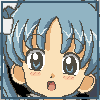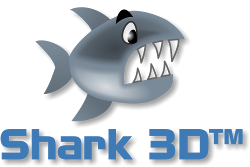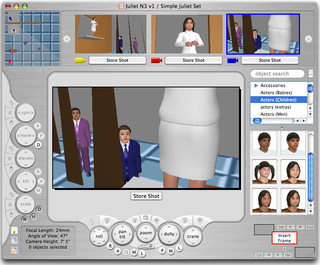
Computer animation is the process used for digitally generating animated images. The more general term computer-generated imagery (CGI) encompasses both static scenes and dynamic images, while computer animation only refers to moving images. Modern computer animation usually uses 3D computer graphics, although 2D computer graphics are still used for stylistic, low bandwidth, and faster real-time renderings. Sometimes, the target of the animation is the computer itself, but sometimes film as well.

Autodesk Maya, commonly shortened to just Maya, is a 3D computer graphics application that runs on Windows, macOS and Linux, originally developed by Alias Systems Corporation and currently owned and developed by Autodesk. It is used to create assets for interactive 3D applications, animated films, TV series, and visual effects.
Autodesk 3ds Max, formerly 3D Studio and 3D Studio Max, is a professional 3D computer graphics program for making 3D animations, models, games and images. It is developed and produced by Autodesk Media and Entertainment. It has modeling capabilities and a flexible plugin architecture and must be used on the Microsoft Windows platform. It is frequently used by video game developers, many TV commercial studios, and architectural visualization studios. It is also used for movie effects and movie pre-visualization. For its modeling and animation tools, the latest version of 3ds Max also features shaders, dynamic simulation, particle systems, radiosity, normal map creation and rendering, global illumination, a customizable user interface, new icons, and its own scripting language.

Poser is a 3D computer graphics program distributed by Bondware. Poser is optimized for the 3D modeling of human figures, and has gained popularity due to beginners being able to produce basic animations and digital images, as well as the extensive availability of third-party digital 3D models.

Motion capture is the process of recording the movement of objects or people. It is used in military, entertainment, sports, medical applications, and for validation of computer vision and robotics. In filmmaking and video game development, it refers to recording actions of human actors, and using that information to animate digital character models in 2D or 3D computer animation. When it includes face and fingers or captures subtle expressions, it is often referred to as performance capture. In many fields, motion capture is sometimes called motion tracking, but in filmmaking and games, motion tracking usually refers more to match moving.

Havok is a middleware software suite developed by the Irish company Havok. Havok provides a physics engine component and related functions to video games.

In computing, an avatar is the graphical representation of the user or the user's alter ego or character. An icon or figure representing a particular person in a video game, Internet forum, etc. It may take either a three-dimensional form, as in games or virtual worlds, or a two-dimensional form as an icon in Internet forums and other online communities. Avatar images have also been referred to as "picons" in the past, though the usage of this term is uncommon now. It can also refer to a text construct found on early systems such as MUDs. The term "avatar" can also refer to the personality connected with the screen name, or handle, of an Internet user.
Autodesk Media and Entertainment is a division of Autodesk which offers animation and visual effects products, and was formed by the combination of multiple acquisitions. In 2018, the company began operating as a single operating segment and reporting unit.

Autodesk Softimage, or simply Softimage is a discontinued 3D computer graphics application, for producing 3D computer graphics, 3D modeling, and computer animation. Now owned by Autodesk and formerly titled Softimage|XSI, the software has been predominantly used in the film, video game, and advertising industries for creating computer generated characters, objects, and environments.
Facial motion capture is the process of electronically converting the movements of a person's face into a digital database using cameras or laser scanners. This database may then be used to produce CG computer animation for movies, games, or real-time avatars. Because the motion of CG characters is derived from the movements of real people, it results in a more realistic and nuanced computer character animation than if the animation were created manually.

Shark 3D is a 3D software program and engine developed by Spinor for creating and running interactive virtual 3D worlds. It is used for video games, films, animated series, broadcasting graphics, and 3D industry applications.

FrameForge Storyboard Studio is previsualization storyboard software used by directors, cinematographers, VFX Supervisor and other creatives in the fields of filmmaking, television production, filmed advertising, industrial videos and other filmed or video content.
MotionBuilder is a 3D character animation software produced by Autodesk. It is used for virtual cinematography, motion capture, and traditional keyframe animation. It was originally named Filmbox when it was first created by Canadian company Kaydara, later acquired by Alias and renamed to MotionBuilder. Alias in turn was acquired by Autodesk.
iClone is a real-time 3D animation and rendering software program that enables users to make 3D animated films. Real-time playback is enabled by using a 3D videogame engine for instant on-screen rendering.

Reallusion is a 2D and 3D character creation and animation software developer with tools for rapid creativity from cartoon characters to digital humans and animation pipelines for films, real-time engines, video games, virtual production, archvis, serious games and training.

Mixamo is a 3D computer graphics technology company. Based in San Francisco, the company develops and sells web-based services for 3D character animation. Mixamo's technologies use machine learning methods to automate the steps of the character animation process, including 3D modeling to rigging and 3D animation.
CrazyTalk is Reallusion's brand name for its 2D animation software. The product series includes CrazyTalk, a 2D facial animation software tool, and CrazyTalk Animator, a face and body 2D animation suite.
Adobe Fuse CC is a 3D computer graphics software developed by Mixamo that enables users to create 3D characters. Its main novelty is the ability to import and integrate user generated content into the character creator. Fuse is part of Mixamo's product suite and it is aimed at video game developers, video game modders, and 3D enthusiasts.
Faceware Technologies is an American company that designs facial animation and motion capture technology. The company was established under Image Metrics and became its own company at the beginning of 2012.








